* This article was earlier published in The Business Entrepreneur magazine.
* Join me on a photography-centric tour to Rajasthan in the last week of November
As my plane hovered over Jaipur City waiting for signal to land, I looked down from the tiny window past the obtrusive wing for my first sight of the desert capital. The view from the top makes it evident that Jaipur is a well planned city. The walled Old City is neatly divided into small blocks with perfectly straight roads crisscrossing them. A few big landmarks like the City Palace and Tal Katora Lake break the monotony and uniformity, but they gel with their surroundings like an artist’s deliberate strokes that enhance a section of the canvas.
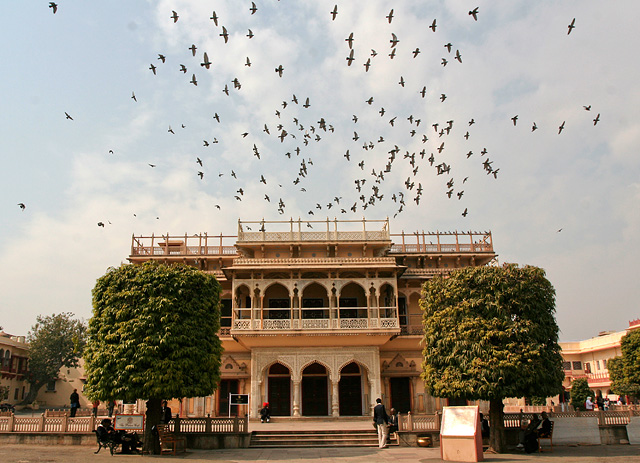
Like most cities with a history that goes back a few centuries, Jaipur is a divided world of old and new. What is now called the old city was build nearly three hundred years ago, when Maharaja Jaisingh II decided move his capital from nearby Amber. He took keen interest in designing and planning the new abode of his people, which explains the well aligned square blocks seen from a bird’s-eye view. A thick wall was build around the city to secure it from invading neighbours, which still survives in parts today.
More than hundred years after the city was built, it received a new artistic infusion when Raja Ram Singh decided to have the whole city painted pink in a gesture to welcome the visiting Prince of Wales. The tradition of pink colour has been preserved even today as it welcomes travellers from across the world, earning it the name ‘pink city’.
The main streets of Old City can surprise even the best informed traveller who sees every building painted in a dark hue of pink. Every shop on the street, whether they sell groceries, clothes or mutual funds, all have the same shape, size and colour. They all look so alike that it requires prominent numbering to distinguish one from other. But order is distinctly broken by occasional shop owners. Modern corporations, ever conscious of an image and with pressures to build their brands, have tried to break out of the monotony and have raised sleek colourful signboards in front of their offices and sales counters, deviating from traditional and lackluster signs in front of all other shops. Perhaps the pink palettes of Jaipur may not survive democracy for very long – it takes a monarchy to bring an order of such degree and have no one question it.
Perhaps the best place to get a good glimpse of Old City is from Iswari Minar Swarg Sal, a tall minaret that offers uninterrupted views. I entered the minaret and climbed up slowly through a helical ramp with tiny windows in every floor that brings in only a little light. The only sign of life in the minaret was pigeons cooing from their roost in the window sill. At the top of the minaret is an open balcony with all-round view of the city. Standing up there, I could see the sprawl of Jaipur – the Aravali Hills spreading to the east limiting the growth of Old City and the plains to the west where the new city is growing quickly. It is easy to spot the major edifices of the old city – Hawa Mahal and City Palace that stand much taller than the two-storey buildings that surround them.
Jaipur’s City Palace, the largest of the monuments in the heart of the walled city, epitomizes the pink city with its long walls painted pink. I entered the palace complex through a narrow gate that isolates the area from traffic, noise and the rush outside. The complex is a large area with empty, wide alleys and open spaces. Large gates with tall arches divide sections of the complex, with fluttering pigeons occupying every inch of free space on the top of the arches. Once in a while they rush out of their perches with loud flutter of wings, collectively strong enough to create small local currents of wind. The amiable Marwaris feed the pigeons generously, letting them thrive and grow plump in the quarters of Old City.
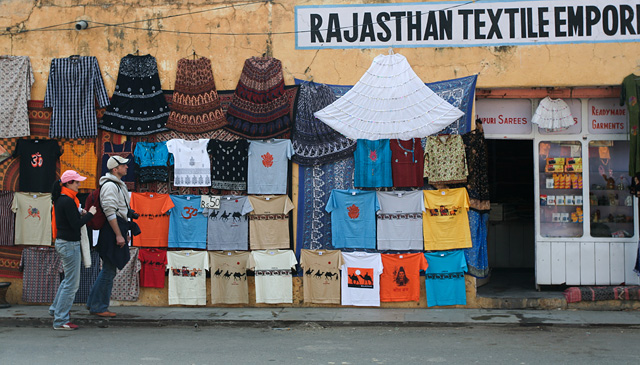
The Palace doubles up as a showcase of the culture and traditions of Rajasthan. A snake charmer welcomes the visitors at the gates with his snake-in-the-box, blowing his pungi and making the snake raise its hood to charm the tourists. It works well. Hoards of tourists from the west who have been oversold with stories of snake charmers, rope-tricksters and elephant riders, tout their camera and smile with a triumph of having seen the India of their conception.
The interiors of the palace are much peaceful, especially for someone who has walked through the rush of the main roads outside. The spacious courtyards can take plenty of tourists and can still feel empty. I walked past Mubarak Mahal – the welcoming hall, the art museums, the arms display and spent some time admiring the large silver pots placed in Diwan-i-Khas. The pots hold Guinness Record for being the largest silver vessels in the world, and were used by King Sawai Madho Singh to carry the waters of Ganga wherever he went. Apparently he would not drink from a source other than the holy river.
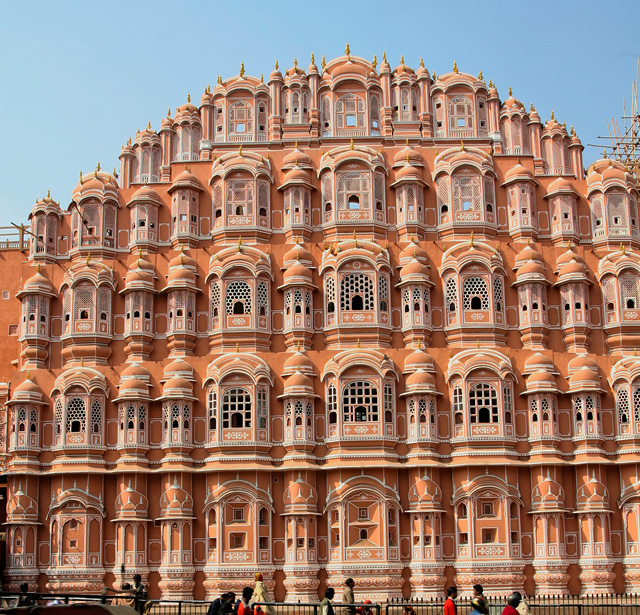
Not for from City Palace is Hawa-Mahal, another pink structure that epitomizes the architecture of Jaipur. Hawa Mahal was built to provide a platform for the women of the palace to see processions passing by the streets during festivals. The Lonely Planet quotes Hawa Mahal as an “extra-ordinary fairy tale”, which is evident on looking at its tall, pink façade with a series of decorated windows. The photogenic outer wall facing the road has a celebratory feel with their bright pink painting and patterns on the windows, earning it a rightful fame. But inside, it is no more than a maze of insipid rooms with peeling plasters, and small windows meant to isolate the royal women with rest of the world.
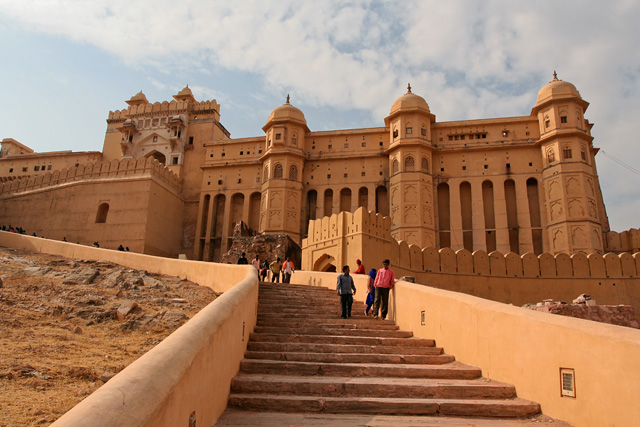
The predecessor to City Palace is Amber Fort, from where the kings had once moved to Jaipur. On the way to the fort, which is a short thirty minute drive from Hawa Mahal, the bustle of the city gives way to a dense pack of trees that now stood bare in the dry winter. But the winding road going up and down through the thick forest is perhaps beautiful and lush green in the monsoons months.
Amber Fort is located on the top of a hill and dominates a long ridge. Standing in a valley and surrounded by fortified hills all around me with a majestic fort on one side, I was impressed by the great effort put by the rulers of Jaipur to protect themselves from possible conflicts. A large tank at the base of the hill matches the fort in size and adds to its beauty, perhaps serving as a source of water for people of the city in the past.
On the way back from the palace, I stopped briefly to watch the golden rays of evening sun fall on Jal Mahal, a small palace built in the middle of Man Sagar Lake. The palace is now left unattended for such a long time that trees have grown over the palace building. It is a sight of nature dominating over man’s creation when allowed to flourish without any interference.
On the way back to my hotel in the evening, I passed through one of the many gates of the Old City that have still survived and marks the separation between old and the new parts of Jaipur. While the Old City has resisted the change over centuries and has steadfastly remained as an icon of the days of the Rajas, the new city symbolizes the new India with its swanky hotels, tall apartment buildings, malls and glass facades. While Jaipur is still not chaotic and disordered like many of India’s large cities, it does seem to be a far cry from the immaculately planned blocks and boulevards I saw in the old city. Going from one side of the gate to the other was like returning to present after a brief journey back in time by two-hundred years.
Forts and walls that go on as far as the ridges of the hills that contain them, red sun setting over orange sand dunes, slippery grains of sand slipping through the feet, starry nights in the middle of the desert whose silence is occasionally interrupted by the camel’s bells, orange turbaned men playing flute and traditional ravan hatha, making the little dolls dance to the tune of soulful music, children dancing to the voices of old men wearing colourful clothes, women in red robes and long skirts walking gracefully with a pot of water leaving behind the sonorous sounds of anklets, temples painted with playful acts of young Lord Krishna and palaces where opulence can’t be bettered. That’s just a few glimpses of what Rajasthan has to offer us, and what we are going to see and photograph. Our photography tour of Rajasthan will leave you lingering for more, and the pictures we bring back will ensure that the memories will never fade.
Dates
- Ten days and nine nights – 25th November, Friday to 4th December 2011, Sunday.
- Optional extension to Udaipur on 5th December 2011.
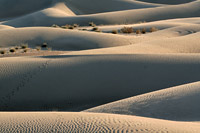
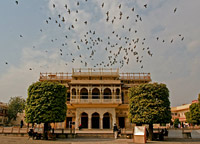
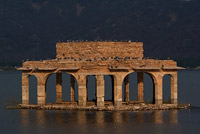
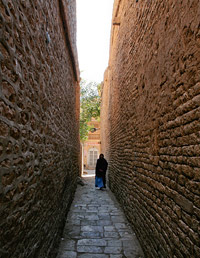
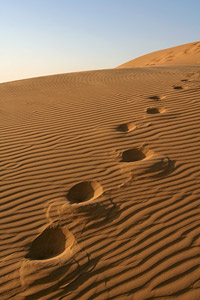
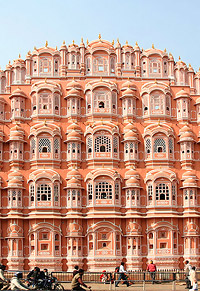
To see full details of the tour and to register, visit Photography Tour to Rajasthan.
Also see: A closer look at bird life in Bharatpur
+ Laughing Dove
+ Rose Ringed Parakeets
+ Butterflies
+ Common Kingfisher
+ Indian Flap Shell Turtles
+ Birds in the Marshes
+ Nilgai
This article appeared in January issue of Harmony magazine.
The small road that cuts through Keoladeo National Park is like a great, open-air aviary, where a medley of bird calls and sudden flashes of colour in the foliage keep you riveted to the spot for hours on end. There’s a mind-boggling variety of migratory birds at this sanctuary in Rajasthan, where I encountered nearly a hundred species living and breeding happily within a 30-sq km, protected area. They had arrived from every part of the world, trusting the safety of the marshland and jungles. And as if to return the favour, they put on a spectacular show for visitors, day after amazing day. The park is so densely populated that no matter where I stood, there were at least half-a-dozen species preening and calling out.
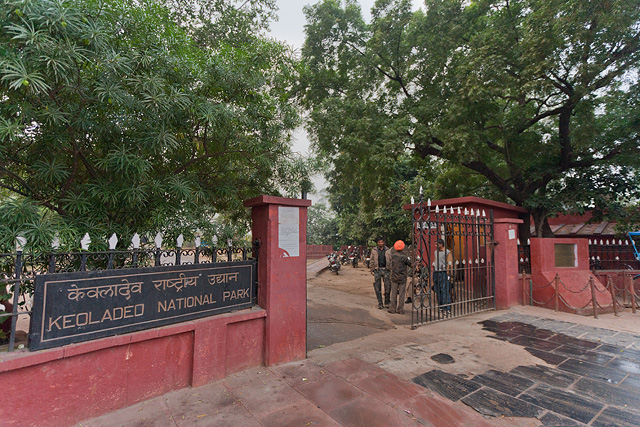
Entrance to Keoladeo National Park
It’s one of history’s ironies that the origin of this national park has nothing to do with protecting birds. More than a century ago, the Maharaja of Bharatpur created these wetlands by damming Gambhir River and diverting its waters to a natural depression. The marshy area thus created began to attract ducks and cranes, which arrived in the winter months. What is a beautiful sanctuary today was thus a protected hunting site, which hosted shooting parties for Indian and British royalty!
This hunting reserve was declared a bird sanctuary in 1956 and named after the Keoladeo Temple located within its boundaries. The sanctuary, with more than 300 species of birds, many of them critically endangered, was later declared a national park and a UNESCO World Heritage Site.
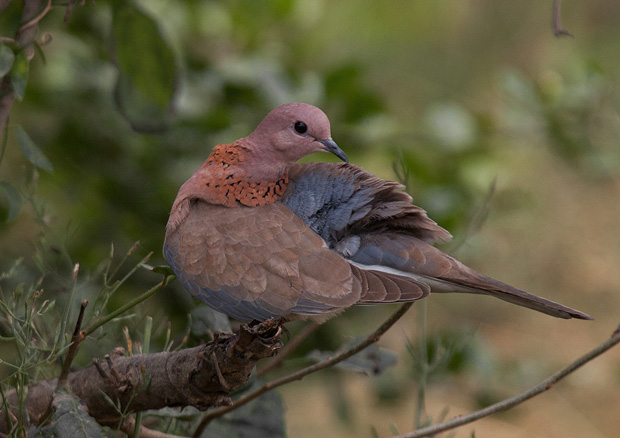
A laughing Dove
On a misty winter morning, I was welcomed by the calls of jungle babblers and Brahminy mynahs that hopped from branch to branch along the trees at the edge of the park. I had barely taken a few steps inside when I spotted a peahen escorting a bunch of young ones foraging on the ground. They quickly disappeared into a bush when the mother saw me watching them and alerted her flock. A minute later, a laughing dove was posing for me gracefully from atop a bush. This was no laughing matter as it silently kept a careful eye on me. But I spotted many of its kind deeper in the jungle, ‘laughing’ in unison at my disappointment.
In my first hour inside the park, I saw only smaller birds commonly found in the Gangetic plains, like rose-ringed parakeets and a variety of shrikes. Parakeets love to chatter and they squawked like there was no tomorrow! Every inch of Bharatpur’s shrub is filled with their raucous calls and yet their green blends so seamlessly with the vegetation that it’s hard to spot them in the trees.
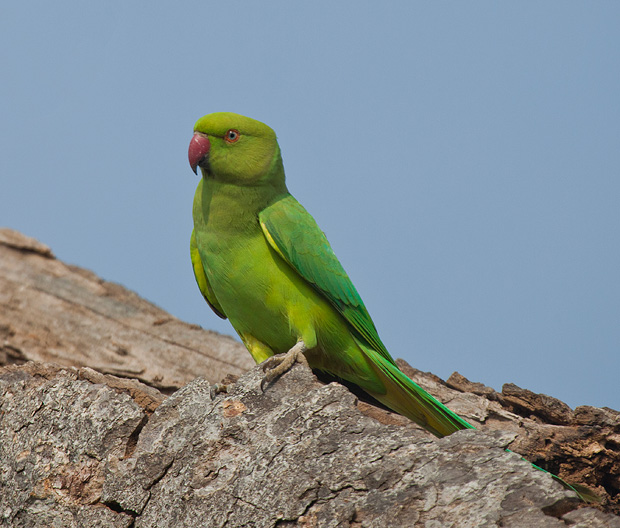
Rose Ringed Parakeet
As I walked further down this great birding highway, birds that were less common were kind enough to make an appearance. The only pair of black-necked storks nesting in the park was feeding happily in knee-deep waters at the edge of the road, showing off shiny blue necks.
After a few days of wandering around the sanctuary, I spotted a fine pair of critically endangered sarus cranes—perhaps the largest of the birds in the park—known to stand almost as tall as a human adult. As I kept watching them, the pair delighted me with a fine display of their courtship dance, jumping up and calling with a loud trumpeting sound. Watching this happy couple alone made my visit to the park rewarding.
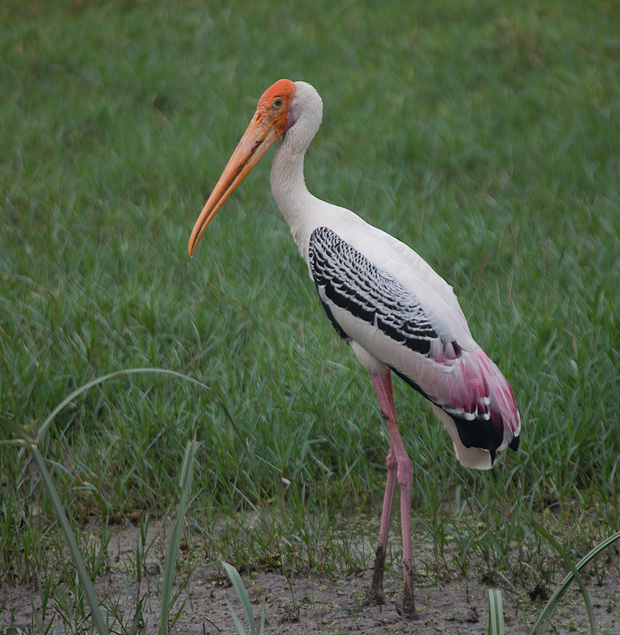
A painted stork
The marshy terrain makes the Keoladeo an ideal habitat for large herons, which need plenty of space and isolation to breed. These large birds were nesting on trees scattered across the swamp. There was a fairly large population of painted storks that stood out with their colourful pink-and-black plumage. Grey herons, with their long necks, were everywhere. Standing absolutely still in knee-deep water, they would suddenly stab at fish with their needle-like, long beaks.
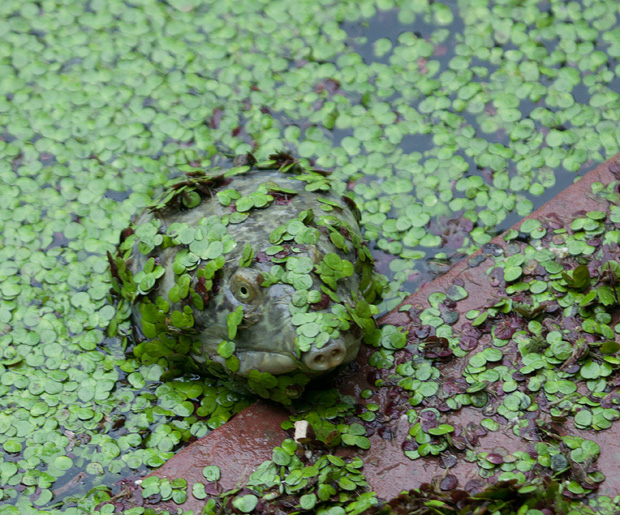
Indian Flap Shell Turtle
There is more to Keoladeo National Park than this massive congregation of birds. The large water body makes it an ideal habitat for flap-shell turtles gently swimming just below the surface. I repeatedly spotted dark, dome-like objects moving slowly in the water for two full days but never once had a face-to-face encounter with the owners of these shells.
It was a full three days later that I found an easy way to get a good look at them, thanks to the generosity of Seetaram Baba. Baba lives at the Hanuman Temple in a corner of the park. He had been feeding the turtles for many years and they now respond to his calls.
One evening, Baba took a vessel filled with dough to the water’s edge. As we watched, standing on the steps leading to the pond, he started calling them, “Aa…aa…aaa.” Within seconds, I saw something stir in the water. Then, a small snout and two tiny eyes popped out near the steps. This was soon followed by another one and another one, all of them emerging with characteristic, turtle-like sluggishness. They fed on the wheat balls slowly and cautiously, coming out of the water only for an instant to gulp the food before disappearing again. They looked gentle and harmless but Baba told me they can collectively tear apart an animal.
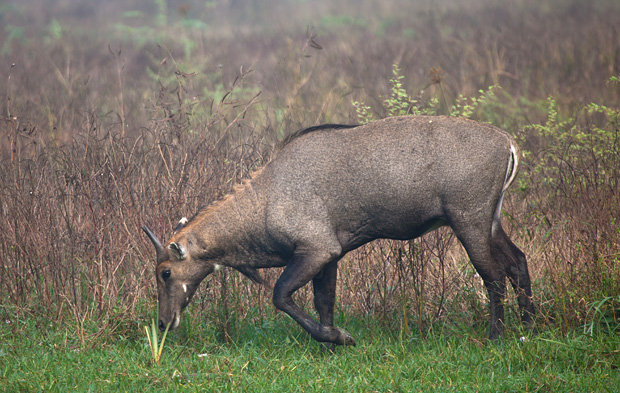
A Nilgai
The park is also home to spotted deer and blue bulls that graze happily on the lush grass at the edge of the marsh. When I was there, there was also a surprise visitor, who was about to stir up things in the jungle. A tiger had wandered into Bharatpur from Ranthambore about 200 km away. Its presence not only posed a danger to the ungulates that were once absolutely safe in the park but was giving the sanctuary management sleepless nights.
Visitors had to be restricted in areas where the tiger was spotted and were asked to leave well before dark every day. I expected tourists to flock to the park with anticipation to spot the big cat among the winged beauties but my guide Captain Singh said people were in fact afraid to venture here for fear of their lives.
While the tiger scare won’t last long, environmental issues have proved more perilous to this avian paradise—many species of migratory birds have failed to show up over the past two decades owing to successive years of drought and lack of sufficient water in the marshes. The increased demand for redirecting the waters of the dam to nearby agricultural fields is making it harder to keep the swamp filled. For instance, the Siberian cranes, once almost the migrant mascots of the park, have not visited Bharatpur in eight years.
The water shortage in Bharatpur is so acute that its World Heritage Site status is now in jeopardy. But efforts are underway to ensure availability of more water in the park. Provisions have been made to fill sections of the marsh using water drawn from tube wells, but it is barely sufficient to save the aquatic flora and fauna. A new canal built to link a nearby reservoir has helped in bringing more water since 2007, but still doesn’t assure required volumes. On the brighter side, the planning commission has approved a proposal for pumping excess waters of Chambal River to the national park. If the project sees light, it can once again ensure that the avian haven of Bharatpur remains a sought after place for the beautiful winged visitors. The sanctuary’s future and sustenance lies in the hands of local people to aid in conservation, state government’s efforts to keep the swamp watered and finally, the will of the weather Gods.
About Keoladeo National Park, Bharatpur
Keoladeo National Park is a small marshland with a very high density of bird population. A large number of winter migrants arrive in the park in the years when there is sufficient water in the marshes. Small roads cut across the marshland, allowing visitors to get a good look at the birds. Access to the park is by foot, cycle rickshaws and bicycles. Cycle Rickshaws and bird guides can be hired at the park entrance on hourly rates. It is recommended to use the services of guides as they are well informed and can show you some birds that you may not easily find yourself. Bicycles are a good way to traverse the park and are available on rent.
The park is just outside the town of Bharatpur, which is an hour’s drive from Agra on the Agra-Jaipur road. It is about five hours by road from Delhi. If you are arriving at Bharatpur from Delhi, the best mode of transport is to use the train (3.5 hours). Buses plying between Bharatpur and Delhi are not exactly in great condition and take anywhere between five to seven hours depending on the traffic.
Many hotels are located on the road just outside the park. Accommodation is usually easy to find except in a couple of popular hotels.
Links
1. Wiki
2. Comprehensive list of birds















